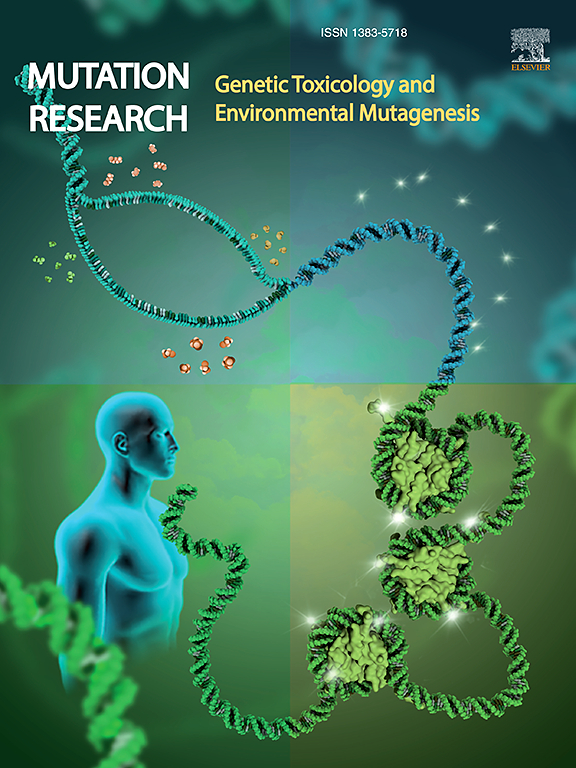基于成纤维细胞的放射敏感性测定作为(严重)联合免疫缺陷综合征的临床有价值的工具
IF 2.5
4区 医学
Q3 BIOTECHNOLOGY & APPLIED MICROBIOLOGY
Mutation research. Genetic toxicology and environmental mutagenesis
Pub Date : 2025-02-01
DOI:10.1016/j.mrgentox.2025.503852
引用次数: 0
摘要
DNA双链断裂(DSB)修复蛋白之一的遗传缺陷导致具有严重临床表现的不同人类综合征,包括神经和免疫发育受损、癌症易感性和对电离辐射的敏感性。由于诊断和治疗过程经常使用DNA损伤剂,识别放射敏感个体是优化患者管理的必要条件。然而,患有(严重)联合免疫缺陷(S)CID的患者通常不适合进行基于淋巴细胞的放射敏感性试验。因此,本研究探讨了两种基于成纤维细胞的检测方法作为替代方法的适用性。通过优化的细胞动力学阻滞微核(MN)测定和γ - h2ax聚焦试验,对确诊或疑似放射敏感(S)CID患者的成纤维细胞进行x射线照射后DSB修复评估。使用这两种检测方法,Artemis缺陷的患者被确定为放射敏感,而RAG1/2缺陷的患者不被认为是放射敏感。虽然在XLF、LIG4或NBS1缺乏的受辐射成纤维细胞中MN评分是不可行的,但在XLF或LIG4缺乏的成纤维细胞中,通过γ - h2ax聚焦试验损伤的DNA DSB修复动力学可以很容易地证明放射敏感性,而在NBS1缺乏的成纤维细胞中则不能。虽然两种ATM缺陷成纤维细胞都明显显示出辐射诱导的MN产量增加,但根据残余γ - h2ax聚焦水平,两种成纤维细胞中的一种不能被确定为辐射敏感。本研究表明,结合成纤维细胞MN试验和γH2AX焦点试验可以有效地排除疑似放射敏感(S)CID患者的体外放射敏感性,特别是在淋巴细胞放射敏感性试验不可行的情况下。本文章由计算机程序翻译,如有差异,请以英文原文为准。
Fibroblast-based radiosensitivity assays as a clinically valuable tool for (severe) combined immunodeficiency syndromes
Genetic defects in one of the DNA double strand break (DSB) repair proteins lead to distinct human syndromes with severe clinical manifestations, including impaired neurological and immunological development, cancer proneness and sensitivity to ionizing radiation. Since diagnostic and therapeutic procedures frequently use DNA damaging agents, identification of radiosensitive individuals is imperative to optimize patient management. However, patients with a (severe) combined immunodeficiency (S)CID are often ineligible for lymphocyte-based radiosensitivity testing. Therefore, this study investigated the suitability of two fibroblast-based assays as alternative methods. DSB repair was evaluated following X-ray irradiation by an optimized cytokinesis-block micronucleus (MN) assay and the γH2AX focus test in fibroblasts from patients with a confirmed or suspected diagnosis of radiosensitive (S)CID. Using both assays, patients with a defect in Artemis were identified as radiosensitive while those with a RAG1/2 deficiency were not considered as radiosensitive. Although MN scoring was not feasible in irradiated fibroblasts deficient in XLF, LIG4 or NBS1, radiosensitivity could be readily demonstrated through impaired DNA DSB repair kinetics with the γH2AX focus assay in fibroblasts deficient in XLF or LIG4, but not in those deficient in NBS1. While both ATM defective fibroblasts clearly showed increased radiation-induced MN yields, one of the two fibroblast cell lines could not be identified as radiosensitive based on residual γH2AX focus levels. This study suggests that combining the fibroblast MN assay and γH2AX focus test can effectively exclude in vitro radiosensitivity in patients with a suspicion of radiosensitive (S)CID, particularly when lymphocyte-based radiosensitivity testing is not feasible.
求助全文
通过发布文献求助,成功后即可免费获取论文全文。
去求助
来源期刊
CiteScore
3.80
自引率
5.30%
发文量
84
审稿时长
105 days
期刊介绍:
Mutation Research - Genetic Toxicology and Environmental Mutagenesis (MRGTEM) publishes papers advancing knowledge in the field of genetic toxicology. Papers are welcomed in the following areas:
New developments in genotoxicity testing of chemical agents (e.g. improvements in methodology of assay systems and interpretation of results).
Alternatives to and refinement of the use of animals in genotoxicity testing.
Nano-genotoxicology, the study of genotoxicity hazards and risks related to novel man-made nanomaterials.
Studies of epigenetic changes in relation to genotoxic effects.
The use of structure-activity relationships in predicting genotoxic effects.
The isolation and chemical characterization of novel environmental mutagens.
The measurement of genotoxic effects in human populations, when accompanied by quantitative measurements of environmental or occupational exposures.
The application of novel technologies for assessing the hazard and risks associated with genotoxic substances (e.g. OMICS or other high-throughput approaches to genotoxicity testing).
MRGTEM is now accepting submissions for a new section of the journal: Current Topics in Genotoxicity Testing, that will be dedicated to the discussion of current issues relating to design, interpretation and strategic use of genotoxicity tests. This section is envisaged to include discussions relating to the development of new international testing guidelines, but also to wider topics in the field. The evaluation of contrasting or opposing viewpoints is welcomed as long as the presentation is in accordance with the journal''s aims, scope, and policies.

 求助内容:
求助内容: 应助结果提醒方式:
应助结果提醒方式:


